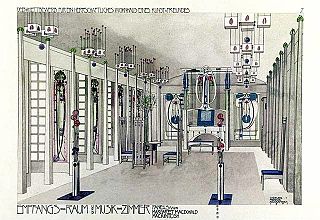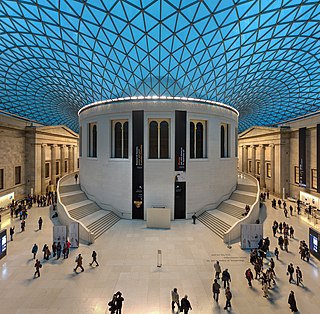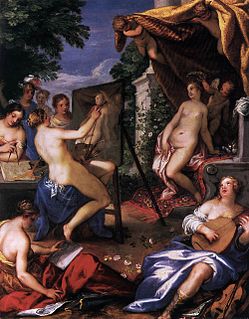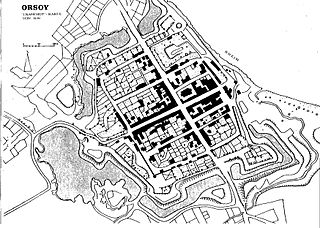
In visual arts, music, and other mediums, minimalism is an art movement that began in post–World War II Western art, most strongly with American visual arts in the 1960s and early 1970s. Prominent artists associated with minimalism include Donald Judd, John McCracken, Agnes Martin, Dan Flavin, Robert Morris, Anne Truitt, and Frank Stella. It derives from the reductive aspects of modernism and is often interpreted as a reaction against abstract expressionism and a bridge to postminimal art practices.
The 3D ACIS Modeler (ACIS) is a geometric modeling kernel developed by Spatial Corporation, part of Dassault Systemes. ACIS is used by many software developers in industries such as computer-aided design (CAD), computer-aided manufacturing (CAM), computer-aided engineering (CAE), architecture, engineering and construction (AEC), coordinate-measuring machine (CMM), 3D animation, and shipbuilding. ACIS provides software developers and manufacturers the underlying 3D modeling functionality.

Interior Architecture is the design of a building or shelter inside out, type home that can be fixed. It can also be the initial design and plan for use, then later redesign to accommodate a changed purpose, or a significantly revised design for adaptive reuse of the building shell. The latter is often part of sustainable architecture practices, conserving resources through "recycling" a structure by adaptive redesign. Generally referred to as the spatial art of environmental design, form and practice, interior architecture is the process through which the interiors of buildings are designed, concerned with all aspects of the human uses of structural spaces. Put simply, Interior Architecture is the design of an interior in architectural terms.
Urban morphology is the study of the form of human settlements and the process of their formation and transformation. The study seeks to understand the spatial structure and character of a metropolitan area, city, town or village by examining the patterns of its component parts and the ownership or control and occupation. Typically, analysis of physical form focuses on street pattern, lot pattern and building pattern, sometimes referred to collectively as urban grain. Analysis of specific settlements is usually undertaken using cartographic sources and the process of development is deduced from comparison of historic maps.

Neo-futurism is a late 20th to early 21st century movement in the arts, design, and architecture. It could be seen as a departure from the attitude of post-modernism and represents an idealistic belief in a better future and "a need to periodize the modern rapport with the technological".

Immersion into virtual reality (VR) is a perception of being physically present in a non-physical world. The perception is created by surrounding the user of the VR system in images, sound or other stimuli that provide an engrossing total environment.

Kinetic architecture is a concept through which buildings are designed to allow parts of the structure to move, without reducing overall structural integrity.

Architectural geometry is an area of research which combines applied geometry and architecture, which looks at the design, analysis and manufacture processes. It lies at the core of architectural design and strongly challenges contemporary practice, the so-called architectural practice of the digital age.

Architecture is both the process and the product of planning, designing, and constructing buildings or any other structures. Architectural works, in the material form of buildings, are often perceived as cultural symbols and as works of art. Historical civilizations are often identified with their surviving architectural achievements.

An architectural drawing or architect's drawing is a technical drawing of a building that falls within the definition of architecture. Architectural drawings are used by architects and others for a number of purposes: to develop a design idea into a coherent proposal, to communicate ideas and concepts, to convince clients of the merits of a design, to enable a building contractor to construct it, as a record of the completed work, and to make a record of a building that already exists.
Organizational space describes the influence of the spatial environment on the health, the mind, and the behavior of humans in and around organizations. It is an area of scientific research in which interdisciplinarity is a central perspective. It draws from management, organization and architecture added with knowledge from, for instance, environmental psychology, social medicine, or spatial science. In essence, it may be regarded as a special field of expertise of organization studies and change management applied to architecture. The knowledge area is related to evidence-based design in which the influence of the spatial environment on patient's health, healing, and customer satisfaction are being researched in health care. It is also related to practice-based areas of management such as facility management which is primarily devoted to the maintenance and care of commercial or institutional buildings and to property management in which the operation of real estate is central. Sometimes it is also referred to as organizational architecture. The scientific field of organizational space must be distinguished from social architecture in which the development of information and communication technologies is central and also different from space science which is concerned with the study of the universe.
Digital morphogenesis is a type of generative art in which complex shape development, or morphogenesis, is enabled by computation. This concept is applicable in many areas of design, art, architecture, and modeling. The concept was originally developed in the field of biology, later in geology, geomorphology, and architecture.

Tessellated roof is a frame and a self-supporting structural system in architecture. A simple ridged roof may inside be a tessellated system. The interlinking shapes are replicated across the moulded surface using curvilinear coordinates, a specific technique with rigid interlinking beams, having characteristics similar to woven fabric. A tessellated roof is one of the most flexible framed systems to design. The measurements and precision are complex and commonly part of a computer-aided design process of production. It is used in a honeycomb geometry form, in the biomes of the Eden Project.

The arts refers to the theory and physical expression of creativity found in human societies and cultures. Major constituents of the arts include literature, performing arts, and visual arts.

A figure-ground diagram is a two-dimensional map of an urban space that shows the relationship between built and unbuilt space. It is used in analysis of urban design and planning. It is akin to but not the same as a Nolli map which denotes public space both within and outside buildings and also akin to a block pattern diagram that records public and private property as simple rectangular blocks. The earliest advocates of its use were Colin Rowe and Fred Koetter.

Sendai Mediatheque is a library in Sendai, Miyagi Prefecture, Japan. It was designed by Toyo Ito in 1995 and completed in 2001.
Open-source architecture (OSArc) is an emerging paradigm that advocates new procedures in imagination and formation of virtual and real spaces within a universal infrastructure. Drawing from references as diverse as open-source culture, modular design, avant-garde architectural theory, science fiction, language theory, and neuro-surgery, it adopts an inclusive approach as per spatial design towards a collaborative use of design and design tools by professionals and ordinary citizen users. The umbrella term citizen-centered design harnesses the notion of open-source architecture, which in itself involves the non-building architecture of computer networks, and goes beyond it to the movement that encompass the building design professions, as a whole.
FINE MEP is a BIM CAD software tool for Building services engineering design, built on top of IntelliCAD. It provides full IFC support, according to the 2x3 IFC Standard. FINE BIM structure, enables a smart model shaping and high design accuracy, directly applied to the real 3D building model and its building services. Not only the building elements, but also the components of the mechanical/electrical installations themselves are all intelligent objects carrying their own attributes and interacting among each other. MEP design is supported by specific CAD commands and further facilitated through sophisticated recognition and validation algorithms, providing a user-friendly modeling environment.
Liu Yichun is a Chinese architect, based in Shanghai, China. After served as Chief Architect of the Architectural Design Institute of Tongji University from 1997 to 2000, he founded his own architecture office Atelier Deshaus with Chen Yifeng and Zhuang Shen in 2001. Trying to keep Chinese traditions alive, Liu borrows the principles and philosophy from ancient Chinese architecture and links them with the present in the attempt to create new meanings of architecture.

Biophilic design is a concept used within the building industry to increase occupant connectivity to the natural environment through the use of direct nature, indirect nature, and space and place conditions. Used at both the building and city-scale, it is argued that this idea has health, environmental, and economic benefits for building occupants and urban environments, with little drawbacks. Although its name was coined in recent history, indicators of biophilic design have been seen in architecture from as far back as the Hanging Gardens of Babylon.
1. Performative Architecture: Beyond Instrumentality Edited by Branko Kolarevic and Ali Malkawi
2. Performative Geometries: Transforming Textiles techniques Edited by Asterios Agkathidis and Gabi Schilling
3. Architecture in the digital age: Design and Manufacturing Edited by Branko Kolarevic
4. Performative Spaces 2, Platforms for everyone – Ben Anderson












